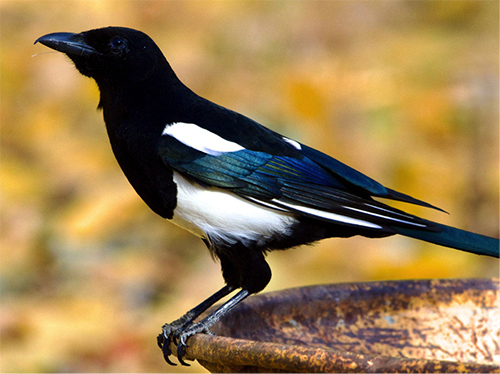BY LARRY BARNES
After a former colleague assigned a bird observation study to his students, a girl came to him with some exciting news.
“Mr. Miller, I saw an amazing bird! It was fairly big, with a really long tail. It was bold, black and white and the black parts even shined blue and green. It was beautiful. What was it!?”
“Have you ever seen this bird before?” asked Mr. Miller.
“Oh, no, never.”
“And how long have you lived here in the Wood River Valley?” asked Mr. Miller.
“My whole life, all 15 years!” said the girl.
Perhaps we all saw the black-billed magpie this way upon first encountering one. But then magpies became part of the background; maybe they committed some sin like teasing the cat, eating the dog food, or noisily following their parents while begging for food. When we first saw them, magpies were new, but they kept showing up and lost their shine. The honeymoon period of awe and wonder that the young student shared with Mr. Miller often fades. This former student is now over 40 and probably no longer breathlessly relates the magnificence of magpies to those she meets.
In pre-Columbian times magpies were likely quite rare in the Wood River Valley, for they were adapted to living in association with bison, which were not locally common. Between about 1820 and 1880 we market-hunted a population of around 30-40 million (or more) bison to the verge of extinction and magpies made a shift. We transformed the land with horses, cattle, sheep, and agriculture ,but the magpie niche was flexible enough that they could settle in amongst us, entangled within the tendrils of the expanding human horde.
Today, black-billed magpies are a bird of the West Central Plains, the Intermountain West, and up to southern Alaska, but not the western parts of California, Oregon, and Washington. Their close cousin, the yellow-billed magpie, is restricted to Central California, which it never leaves, and the Sierra mountains keep the two species apart.
Now in March, magpie pairs are busy with their nests, beach-ball-sized domed assemblages of sticks, usually high in a tree. The female incubates her ~6 eggs for about 18 days and the nestlings grow for 3-4 weeks before flying. If you see a group of magpies foraging together in the spring that you suspect to be a family, look at their tails. If all but two have short tails, they are a family.
We are proud of our large brains and therefore often take particular interest in other comparatively brainy creatures. The jays, ravens, crows, and magpies belong to a bird family of fellow brainiacs and studies routinely reveal new intellectual powers among them. Magpies cache food in hiding places, but know if someone might be watching and will take measures to trick their nosy neighbors. If humans are involved in some kind of terrifying magpie study involving repeated weighing of chicks, for example, the magpies will learn to recognize these enemies by their faces, mobbing them with fury, even if far from their nest, while ignoring innocent humans. They’ve even been known to move their precious eggs to a new, safer location.
Magpies are monogamous, and we fancy having that in common with them, too. But they can be “obnoxious,” whatever that means, and they have egregiously become common among us. But none of this changes the awe and wonder felt by those who see them for the first time — when they see black-billed magpies as they truly are.
Larry Barnes retired from 26 years as a biology teacher at Wood River High School and is now transitioning to spending more time exploring the natural world.



